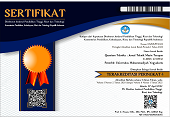Analisis Pembuatan Bahan Bakar dari Pirolisis Thermal dan Katalitik Limbah Plastik Low Density Polyethylene
Abstract
Increasing global warming due to the uncontrolled use of fossil fuels has resulted in climate change which is currently a worldwide concern. Various efforts to use alternative energy have been made to overcome these problems, one of which is Pyrolysis technology to convert solid plastic waste into liquid fuel. Pyrolysis is a heating process, or the working principle is the same as distilling a raw material particle that will change shape from a solid to a gas and then passing through a condenser tube to cool down so that the steam will turn into a liquid. This process generally takes place at temperatures between 500-800°C. The pyrolysis process occurs with the help of heating from LPG gas. From the data obtained, further testing can be carried out on the physical and chemical properties of the pyrolysis oil to determine its characteristics. The physical properties tested included density and viscosity, while the chemical properties tested were the calorific value of the plastic pyrolysis process. The next step is to test the pyrolysis oil using WBT (Water Boiling Test) to determine the performance of the oil stove with pyrolysis oil as fuel. From the results of the efficiency of the stove from the pyrolysis of plastic oil, it is known that the largest input energy (Qin) is obtained in the pyrolysis oil without a catalyst in the first condenser of 2375,291 watts. The result of sensible heat (SH) of the most significant pyrolysis oil sample from pyrolysis without a catalyst in condenser one is 125.4 watts. The highest latent heat value was found in the pyrolysis of natural zeolite catalyst in condenser three at 231.752 watts, while the highest thermal efficiency value of pyrolysis using natural zeolite catalyst in condenser one was 28.39%. Natural zeolite catalysts reduce the liquid and solid products but increase gas products. The catalysts from pyrolysis oil have a darker color than without a catalyst. The cause is the reaction of the catalyst during the pyrolysis process.
Keywords
Full Text:
PDFReferences
Istadi. 2011. Teknologi Katalis untuk Konversi Energi: Fundamental dan Aplikasi, Graha Ilmu: Yogyakata
Juliastuti, S.R., Hendrianie, Nuniek., Febrianto, Arief., Ramadhika, D. Dinar. 2015. Pengolahan Limbah Plastik Kemasan Multilayer LDPE dengan Menggunakan Metode Pirolisis Microwave. Seminar Nasional Teknik Kimia. ISSN1693-4303. Yogyakarta.
Santoso, Joko. 2010. Uji Sifat Minyak Pirolisis dan Uji Performasi Kompor Berbahan Bakar Minyak Pirolisis dari Sampah Plastik. Skripsi Teknik Mesin. Universitas Sebelas Maret. Surakarta.
Surdia. T., & Saito. S. 2005. Pengetahuan Bahan Teknik, PT. Pradnya Paramita: Jakarta.
Surono, Untoro Budi. 2013. Berbagai Metode Konversi Sampah Plastik Menjadi Bahan Bakar Minyak. Jurnal Teknik. April 2013. Vol 3. Nomor 1. Universitas Janabadra. Yogyakarta.
Wardhana, Bhisma Prabuditya Wisnu Wardhana. 2014. Studi Eksperimental Pembuatan Bahan Bakar Dari Limbah Plastik LDPE dengan Proses Pirolisis Termal dan Katalitik (Zeolit Alam & Y) Serta Uji Performasi Mesin Diesel. Tesis Sarjana S2, Univeritas Gadjah Mada. Yogyakarta.
DOI: https://doi.org/10.18196/jqt.v3i2.14141
Refbacks
- There are currently no refbacks.
Copyright (c) 2022 Quantum Teknika : Jurnal Teknik Mesin Terapan

This work is licensed under a Creative Commons Attribution-NonCommercial 4.0 International License.
Quantum Teknika : Jurnal Teknik Mesin Terapan is indexed by :
Office:
Editorial of Quantum Teknika, Building D, Jl. Brawijaya, Tamantirto, Kasihan, Bantul, Yogyakarta.Telp: (0274) 387656
Fax: (0274) 387646
WA: +62896-7470-8638 (Mirza Yusuf)
Email: jqt@umy.ac.id

Quantum Teknika : Jurnal Teknik Mesin Terapan is licensed under a Creative Commons Attribution-NonCommercial 4.0 International License.















.png)